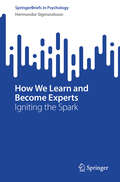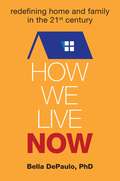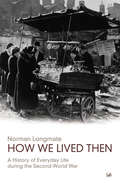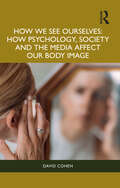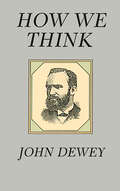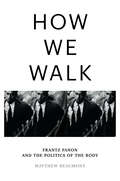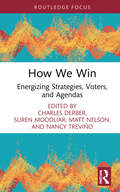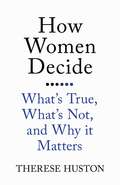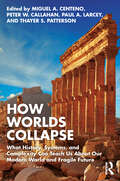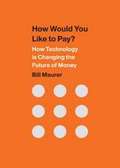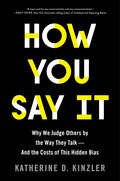- Table View
- List View
How We Know What Isn't So: The Fallibility Of Human Reason In Everyday Life
by Thomas GilovichGilovich illustrates his points with vivid examples and supports them with the latest research findings in a wise and readable guide to the fallacy of the obvious in everyday life.
How We Learn and Become Experts: Igniting the Spark (SpringerBriefs in Psychology)
by Hermundur SigmundssonThis book explores how we learn new skills and knowledge. The book also focuses on how we become experts. Currently, there is an understanding that experts and expertise are made, and thus, deliberate practice and follow-up are needed over time to excel over the years. This volume will also analyze which factors may be important to be able to train your brain and behavior to develop expertise. Passion may be one such factor; others may be grit and a growth mindset.
How We Live Now
by Bella DepauloA close-up examination and exploration, How We Live Now challenges our old concepts of what it means to be a family and have a home, opening the door to the many diverse and thriving experiments of living in twenty-first century America.Across America and around the world, in cities and suburbs and small towns, people from all walks of life are redefining our "lifespaces"--the way we live and who we live with. The traditional nuclear family in their single-family home on a suburban lot has lost its place of prominence in contemporary life. Today, Americans have more choices than ever before in creating new ways to live and meet their personal needs and desires. Social scientist, researcher, and writer Bella DePaulo has traveled across America to interview people experimenting with the paradigm of how we live. In How We Live Now, she explores everything from multi-generational homes to cohousing communities where one's "family" is made up of friends and neighbors to couples "living apart together" to single-living, and ultimately uncovers a pioneering landscape for living that throws the old blueprint out the window. Through personal interviews and stories, media accounts, and in-depth research, How We Live Now explores thriving lifespaces, and offers the reader choices that are freer, more diverse, and more attuned to our modern needs for the twenty-first century and beyond.
How We Lived Then: History of Everyday Life During the Second World War, A
by Norman LongmateAlthough nearly 90% of the population of Great Britain remained civilians throughout the war, or for a large part of it, their story has so far largely gone untold. In contrast with the thousands of books on military operations, barely any have concerned themselves with the individual's experience. The problems of the ordinary family are barely ever mentioned - food rationing, clothes rationing, the black-out and air raids get little space, and everyday shortages almost none at all. This book is an attempt to redress the balance; to tell the civilian's story largely through their own recollections and in their own words.
How We See Ourselves: How Psychology, Society and the Media Impact our Body Image
by David CohenThis light-hearted and entertaining book, authored by top psychologist David Cohen, explores the influences and impacts on our perception of body image, examining the power of appearance and the psychology behind how we think and feel about ourselves physically.Packed with scientific findings alongside historical anecdotes and humorous insights, the book first looks at the history of body image and appearance, and how ideals of beauty have changed over time. It goes on to note the rise of the beauty and fashion industries, looking at how society, culture and the media can affect body image. The final section deals with issues of body dissatisfaction and the treatments and therapy available for those struggling with body image and mental health. Along the way, readers will meet a cast of characters from Elizabeth I, a daring, medieval Welsh poet, an Egyptian mummy with the first known tattoo, Paul F. Schilder who pioneered the study of body image, and the brave recipients of the first face transplants, among many more.In his trademark engaging style, Cohen offers a rich account of the psychology of body image through the ages and through the lifespan. It is valuable reading for students of psychology and professionals and therapists aiming to promote body positivity.
How We Think
by John DeweyOne of America’s foremost philosophers, John Dewey (1859-1952) fought for civil and academic freedom, founded the Progressive School movement, and steadfastly promoted a scientific approach to intellectual development.In How We Think, Dewey shares his views on the educator’s role in training students to think well. Basing his assertions on the belief that knowledge is strictly relative to human interaction with the world, he considers the need for thought training, its use of natural resources, and its place in school conditions; inductive and deductive reasoning, interpreting facts, and concrete and abstract thinking; the functions of activity, language, and observation in thought training; and many other subjects.John Dewey’s influence on American education and philosophy is incalculable. This volume, as fresh and inspirational today as it was upon its initial publication a century ago, is essential for anyone active in the field of teaching or about to embark on a career in education.
How We Walk: Frantz Fanon and the Politics of the Body
by Matthew Beaumont"In this fascinating and wide-ranging book, Beaumont reminds us that walking is far from a neutral activity. With the help of Frantz Fanon, Beaumont locates freedom at the level of the body; free from the systems of oppression, exploitation, and harassment."–Lauren Elkin, author of FlâneuseHow race, class, and politics influence the way we moveYou can tell a lot about people by how they walk. Matthew Beaumont argues that our standing, walking body holds the social traumas of history and its racialized inequalities. Our posture and gait reflect our social and political experiences as we navigate the city under capitalism. Through a series of dialogues with thinkers and walkers, his book explores the relationship between freedom and the human bodyHow We Walk foregrounds the work of Frantz Fanon, psychiatrist and leading thinker of liberation, who was one of the first people to think about the politics of &‘walking while black&’. It also introduces us to the renegade psychoanalyst Wilhelm Reich, who wrote that one could discern the truth about a person through their posture and gait. For Marxist philosopher Ernst Bloch, the ability to walk upright and with ease is a sign of personal and social freedom.Through these excursions, Beaumont reimagines the canonical literature on walking and presents a new interpretation of the impact of class and race on our physical and political mobility, raising important questions about the politics of the body.
How We Win: Energizing Strategies, Voters, and Agendas (Universalizing Resistance)
by Charles Derber, Suren Moodliar, Matt Nelson, and Nancy TreviñoThis book uniquely demonstrates how a new combination of communities, progressive visions, and strategies provides a path to defeat fascist machinations and strengthens social justice movements. Taking the incredible twists and turns of elections as a given, the book takes the issues, grievances and solutions of social movements as its grounding.Would-be change agents, be they first-time voters, freshly minted activists, impacted communities, or veteran strategists, will find answers to questions of voting, organizing, and mobilization. In doing so, readers will find answers to activating their networks and communities not merely to vote, but how to build on their “Emergency Election” mobilizing and power-building efforts to win their agendas, regardless of who holds office.This theoretically and empirically informed handbook for activists, voters, their organizations, unions, and communities provides both mobilizing tools and talking points about the elections’ most vital and contested issues.
How Women Decide: What's True, What's Not, and Why It Matters
by Therese HustonWhen a man faces a difficult decision, he needs to make a judgement. When a woman faces the same decision, she must also deal with being judged. It's hardly surprising then that even the smartest women mislabel their rational decisions as a product of their 'female intuition' - a long-running myth that still prevails today. The reality is women are often the best decision-makers, but for all the wise words out there about how we decide, very few have been written with women in mind.In this path-breaking book, Therese Huston provides a much-needed corrective. Drawing on personal interviews with business leaders and expert data analysis, she demonstrates the unique psychological differences between the sexes that affect how women work, lead and make big life choices. Passionate, persuasive and superbly researched, How Women Decide offers a wealth of practical and enlightening insights, enabling women to make stronger, smarter decisions in a world that still whispers they can't.
How Work Works: The Subtle Science of Getting Ahead Without Losing Yourself
by Michelle P. KingA unique and revelatory guide to understanding and navigating the unwritten rules of the workplace—the key to achieving success, finding meaning, and staying true to your authentic self in today’s business world—from the organizational expert and celebrated author of The Fix.In her two decades researching organizations, Michelle King has discovered that people who succeed possess a particularly unique skill: They know how workplaces work. More specifically, to get ahead, they do not rely on the often generic and outdated written formal rules that for a century have defined the workplace. Instead, they have learned to gauge how they should behave and perform by becoming aware of informal (and unspoken) rules that exist just below the surface, rather than “formal” organizational guidelines. In this one-of-a-kind guide, King offers her proprietary framework based on over ten years of research and hundreds of employees who reached leadership positions. By focusing on five key areas -- navigating informal networks; developing self-awareness and awareness of others; learning the skills you need to be adaptive to changing conditions; getting support for your next promotion; and finding meaning and fulfillment at work—King teaches every professional how to understand and make these systems work for them and achieve their career ambitions.The new world of work requires a new way of working. With more people vying for top positions, a volatile unpredictable global workplace, and an ever-evolving landscape, it is increasingly important for employees to understand how to negotiate the unspoken and intangible elements of workplace culture.. In How Work Works, King dispels old myths and provides keen observations about what it means to find belonging, build networks, manage the informal and ultimately thrive at work.
How Worlds Collapse: What History, Systems, and Complexity Can Teach Us About Our Modern World and Fragile Future
by Miguel A. Centeno, Peter W. Callahan, Paul A. Larcey, Thayer S. PattersonAs our society confronts the impacts of globalization and global systemic risks—such as financial contagion, climate change, and epidemics—what can studies of the past tell us about our present and future? How Worlds Collapse offers case studies of societies that either collapsed or overcame cataclysmic adversity. The authors in this volume find commonalities between past civilizations and our current society, tracing patterns, strategies, and early warning signs that can inform decision-making today. While today’s world presents unique challenges, many mechanisms, dynamics, and fundamental challenges to the foundations of civilization have been consistent throughout history—highlighting essential lessons for the future.
How Would You Like to Pay?: How Technology Is Changing the Future of Money
by Bill MaurerFrom Bitcoin to Apple Pay, big changes seem to be afoot in the world of money. Yet the use of coins and paper bills has persisted for 3,000 years. In How Would You Like to Pay?, leading anthropologist Bill Maurer narrates money's history, considers its role in everyday life, and discusses the implications of how new technologies are changing how we pay. These changes are especially important in the developing world, where people who lack access to banks are using cell phones in creative ways to send and save money. To truly understand money, Maurer explains, is to understand and appreciate the complex infrastructures and social relationships it relies on. Engaging and straightforward, How Would You Like to Pay? rethinks something so familiar and fundamental in new and exciting ways. Ultimately, considering how we would like to pay gives insights into determining how we would like to live.
How You Can Help: An Easy Guide to Doing Good Deeds in Your Everyday Life
by William D. CoplinFirst published in 2000. Routledge is an imprint of Taylor & Francis, an informa company.
How You Say It: Why We Judge Others by the Way They Talk—and the Costs of This Hidden Bias
by Katherine D. KinzlerFrom &“one of the most brilliant young psychologists of her generation&” (Paul Bloom), a groundbreaking examination of how speech causes some of our deepest social divides—and how it can help us overcome them We gravitate toward people like us; it&’s human nature. Race, class, and gender shape our social identities, and thus who we perceive as &“like us&” or &“not like us.&” But one overlooked factor can be even more powerful: the way we speak. As the pioneering psychologist Katherine Kinzler reveals in How You Say It, the way we talk is central to our social identity because our speech largely reflects the voices we heard as children. We can change how we speak to some extent, whether by &“code-switching&” between dialects or by learning a new language; over time, our speech even changes to reflect our evolving social identity and aspirations. But for the most part, we are forever marked by our native tongue—and are hardwired to prejudge others by theirs, often with serious consequences. Someone&’s accent alone can determine the economic opportunity or discrimination they encounter in life, making speech one of the most urgent social-justice issues of our day. Our linguistic differences present challenges, Kinzler shows, but they also can be a force for good. Humans can benefit from being exposed to multiple languages—a paradox that should inspire us to master this ancient source of tribalism and rethink the role that speech plays in our society.
How social security works: An introduction to benefits in Britain
by Paul SpickerHow social security works is an introduction to the much-misunderstood system of benefits in Britain. The book is an accessible, broadly based and sometimes controversial text which can help readers to make sense of the system in practice. It explains the guiding principles, outlines the social context, considers the development and political dimensions of benefits, and reviews how the system operates now. There are detailed discussions of the types of benefit, and the contingencies covered by the benefits system. Paul Spicker examines whether the system offers value for money, how it could be simplified and how it can be improved. The book will be useful to students on undergraduate and professional courses, but beyond that it will appeal to policy makers, practitioners and a broader general readership.
How the Best Leaders Lead: Proven Secrets to Getting the Most Out of Yourself and Others
by Brian TracyThe world&’s greatest business leaders make it all look easy because they keep it simple: measurable, repeatable methods that generate exceptional results in both strong markets and weak, good economies and bad.Leadership expert Brian Tracy has guided countless thousands of professionals, executives, and leaders of all stripes to truly startling results through his business books, seminars and consulting work.In How the Best Leaders Lead, Tracy breaks down the art and science of business leadership into the seven fundamental responsibilities that outstanding leaders master. Essential for success in any organization and every leadership position, they are:Setting and achieving goalsFostering innovationProblem solving and decision makingSetting prioritiesSetting high standards and leading by exampleInspiring and motivating othersPerforming and achieving resultsThis book will take you through a thorough self-analysis with which you will discover what is truly important to you—and identify the specific steps you must take to achieve it. You&’ll then listen Tracy&’s life-changing lessons culled from the leading edges of business, the annals of history and military strategy, and the wisdom of the world&’s most powerful leadership and management thinkers past and present.Leadership is an exact science but a simple one, born of clear vision and courage, self -knowledge and integrity, focus and confidence. With acute insight and Tracy&’s accessible guidance, How the Best Leaders Lead brings those powerful attributes and leadership greatness easily within your reach.
How the Clinic Made Gender: The Medical History of a Transformative Idea
by Sandra EderAn eye-opening exploration of the medical origins of gender in modern US history. Today, a world without “gender” is hard to imagine. Gender is at the center of contentious political and social debates, shapes policy decisions, and informs our everyday lives. Its formulation, however, is lesser known: Gender was first used in clinical practice. This book tells the story of the invention of gender in American medicine, detailing how it was shaped by mid-twentieth-century American notions of culture, personality, and social engineering. Sandra Eder shows how the concept of gender transformed from a pragmatic tool in the sex assignment of children with intersex traits in the 1950s to an essential category in clinics for transgender individuals in the 1960s. Following gender outside the clinic, she reconstructs the variable ways feminists integrated gender into their theories and practices in the 1970s. The process by which ideas about gender became medicalized, enforced, and popularized was messy, and the route by which gender came to be understood and applied through the treatment of patients with intersex traits was fraught and contested. In historicizing the emergence of the sex/gender binary, Eder reveals the role of medical practice in developing a transformative idea and the interdependence between practice and wider social norms that inform the attitudes of physicians and researchers. She shows that ideas like gender can take on a life of their own and may be used to question the normative perceptions they were based on. Illuminating and deeply researched, the book closes a notable gap in the history of gender and will inspire current debates on the relationship between social norms and medical practice.
How the Clinic Made Gender: The Medical History of a Transformative Idea
by Sandra EderAn eye-opening exploration of the medical origins of gender in modern US history. Today, a world without “gender” is hard to imagine. Gender is at the center of contentious political and social debates, shapes policy decisions, and informs our everyday lives. Its formulation, however, is lesser known: Gender was first used in clinical practice. This book tells the story of the invention of gender in American medicine, detailing how it was shaped by mid-twentieth-century American notions of culture, personality, and social engineering. Sandra Eder shows how the concept of gender transformed from a pragmatic tool in the sex assignment of children with intersex traits in the 1950s to an essential category in clinics for transgender individuals in the 1960s. Following gender outside the clinic, she reconstructs the variable ways feminists integrated gender into their theories and practices in the 1970s. The process by which ideas about gender became medicalized, enforced, and popularized was messy, and the route by which gender came to be understood and applied through the treatment of patients with intersex traits was fraught and contested. In historicizing the emergence of the sex/gender binary, Eder reveals the role of medical practice in developing a transformative idea and the interdependence between practice and wider social norms that inform the attitudes of physicians and researchers. She shows that ideas like gender can take on a life of their own and may be used to question the normative perceptions they were based on. Illuminating and deeply researched, the book closes a notable gap in the history of gender and will inspire current debates on the relationship between social norms and medical practice.
How the Clinic Made Gender: The Medical History of a Transformative Idea
by Sandra EderAn eye-opening exploration of the medical origins of gender in modern US history. Today, a world without “gender” is hard to imagine. Gender is at the center of contentious political and social debates, shapes policy decisions, and informs our everyday lives. Its formulation, however, is lesser known: Gender was first used in clinical practice. This book tells the story of the invention of gender in American medicine, detailing how it was shaped by mid-twentieth-century American notions of culture, personality, and social engineering. Sandra Eder shows how the concept of gender transformed from a pragmatic tool in the sex assignment of children with intersex traits in the 1950s to an essential category in clinics for transgender individuals in the 1960s. Following gender outside the clinic, she reconstructs the variable ways feminists integrated gender into their theories and practices in the 1970s. The process by which ideas about gender became medicalized, enforced, and popularized was messy, and the route by which gender came to be understood and applied through the treatment of patients with intersex traits was fraught and contested. In historicizing the emergence of the sex/gender binary, Eder reveals the role of medical practice in developing a transformative idea and the interdependence between practice and wider social norms that inform the attitudes of physicians and researchers. She shows that ideas like gender can take on a life of their own and may be used to question the normative perceptions they were based on. Illuminating and deeply researched, the book closes a notable gap in the history of gender and will inspire current debates on the relationship between social norms and medical practice.
How the Internet Changed America
by Alexei AnisinThis book investigates societal shifts induced by internet technologies. Alexei Anisin applies Anthony Giddens' structuration theory to analyze interactions between digital structures and human agency. He argues against deterministic narratives about technological change, emphasizing the contingent and dynamic nature of digital platforms and their relation to societal behaviors. Digital technologies generate new structures that shape societal behaviors, which are reshaped by human agency through reciprocity and structuration. This book observes declining civic participation, demonstrating that online interactions can expand virtual communities while contributing to physical social isolation and decreased interpersonal and societal trust. Online interactions are also shown to have increased political polarization through deepening ideological division and reducing trust in key governmental institutions. Additionally, high screen time and social media use have led to record declines in traditional reading habits, especially among younger generations who prioritize fast and digestible sensationalist content. Anisin theorizes the rise of social media influencers who have impacted cultural norms through a dynamic interplay between influencer-led content production, digital structures, algorithms, and reoccurring interactions with followers, while also addressing how the integration of private tech resources with state-led surveillance is eroding individual privacy and altering political outcomes.
How the Internet Shapes Collective Actions
by Sandy SchumannAfter a Facebook rebellion in Egypt and Twitter protests in Turkey, the internet has been proclaimed as a globe-shifting, revolutionizing force that can incite complex social phenomena such as collective actions. This book critically assesses this claim and highlights how internet use can shape mobilizing processes to foster collective actions.
How the Mighty Fall: And Why Some Companies Never Give In
by Jim CollinsDecline can be avoided. Decline can be detected. Decline can be reversed. Amidst the desolate landscape of fallen great companies, Jim Collins began to wonder: How do the mighty fall? Can decline be detected early and avoided? How far can a company fall before the path toward doom becomes inevitable and unshakable? How can companies reverse course? In How the Mighty Fall, Collins confronts these questions, offering leaders the well-founded hope that they can learn how to stave off decline and, if they find themselves falling, reverse their course. Collins' research project-more than four years in duration-uncovered five step-wise stages of decline: Stage 1: Hubris Born of Success, Stage 2: Undisciplined Pursuit of More, Stage 3: Denial of Risk and Peril, Stage 4: Grasping for Salvation, Stage 5: Capitulation to Irrelevance or Death. By understanding these stages of decline, leaders can substantially reduce their chances of falling all the way to the bottom. Great companies can stumble, badly, and recover. Every institution, no matter how great, is vulnerable to decline. There is no law of nature that the most powerful will inevitably remain at the top. Anyone can fall and most eventually do. But, as Collins' research emphasizes, some companies do indeed recover--in some cases, coming back even stronger-even after having crashed into the depths of Stage 4. Decline, it turns out, is largely self-inflicted, and the path to recovery lies largely within our own hands. We are not imprisoned by our circumstances, our history, or even our staggering defeats along the way. As long as we never get entirely knocked out of the game, hope always remains. The mighty can fall, but they can often rise again.
How the Other Half Lives (The Bedford Series in History and Culture #110)
by Jacob A. RiisJacob Riis's famed 1890 photo-text addressed the problems of tenement housing, immigration, and urban life and work at the beginning of the Progressive era. David Leviatin edited this complete edition of How the Other Half Lives to be as faithful to Riis's original text and photography as possible. Uncropped prints of Riis's original photographs replace the faded halftones and drawings from photographs that were included in the 1890 edition. Related documents added to the second edition include a stenographic report of one of Riis's lantern-slide lectures that demonstrates Riis's melodramatic techniques and the reaction of his audience, and five drawings that reveal the subtle but important ways Riis's photographs were edited when they were reinterpreted as illustrations in the 1890 edition. The book's provocative introduction now addresses Riis's ethnic and racial stereotyping and includes a map of New York's Lower East Side in the 1890s. A new list of illustrations and expanded chronology, questions for consideration, and selected bibliography provide additional support.
How the Social Sciences Think about the World's Social: Outline of a Critique (Beyond the Social Sciences #2)
by Michael KuhnAt the beginning of the new millennium, the social sciences took an epochal 'turn' that revolutionized their theory-building. As a response to what they called the globalization of the social, they found the need to globalize their theorizing as well. It is curious that only after two centuries of colonialism and imperialism, after two world wars and several economic world crises, did they discover that there is a world beyond the national socials; it is even more strange that the social sciences globalize their theorizing by comparing theories about nationally confined socials and by creating all sorts of 'local' theories, as if any national social was a secluded social biotope. Trying to globalize the social sciences, they argue that globalizing social science theorizing means finding a way of theorizing that must, above all, be liberated from 'scientism' in order to allow a 'provincialization' of thinking. Not surprisingly, the globalizing social sciences have also rediscovered mythological and moral thinking as a means for a true scientific universalism. Michael Kuhn argues that the oddities of the globalizing social sciences are not accidents, but a consequence of the nature of how the social sciences theorize about the social.
How the United States Racializes Latinos: White Hegemony and Its Consequences
by Joe R. Feagin Jorge Duany José A. CobasMexican and Central American undocumented immigrants, as well as U.S. citizens such as Puerto Ricans and Mexican-Americans, have become a significant portion of the U.S. population. Yet the U.S. government, mainstream society, and radical activists characterize this rich diversity of peoples and cultures as one group alternatively called "Hispanics," "Latinos," or even the pejorative "Illegals." How has this racializing of populations engendered governmental policies, police profiling, economic exploitation, and even violence that afflict these groups? From a variety of settings-New York, New Jersey, Los Angeles, Central America, Cuba-this book explores this question in considering both the national and international implications of U.S. policy. Its coverage ranges from legal definitions and practices to popular stereotyping by the public and the media, covering such diverse topics as racial profiling, workplace discrimination, mob violence, treatment at border crossings, barriers to success in schools, and many more. It shows how government and social processes of racializing are too seldom understood by mainstream society, and the implication of attendant policies are sorely neglected.

